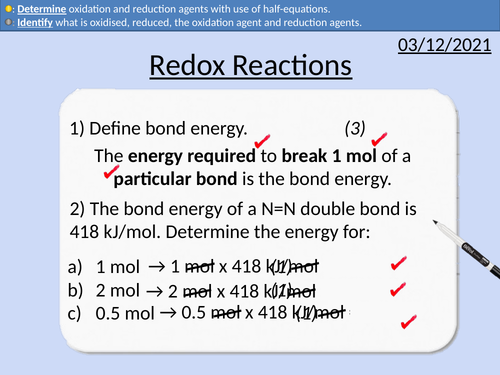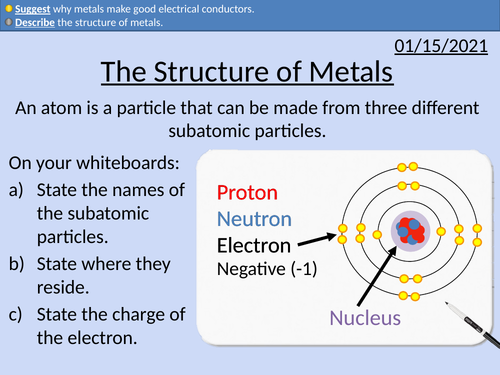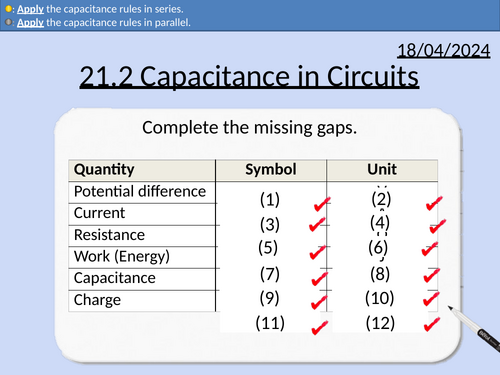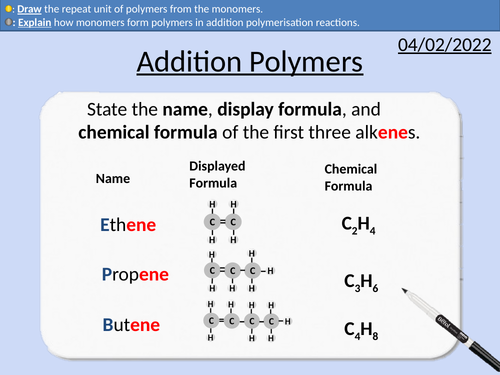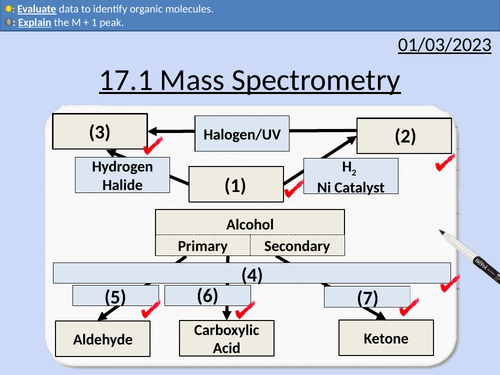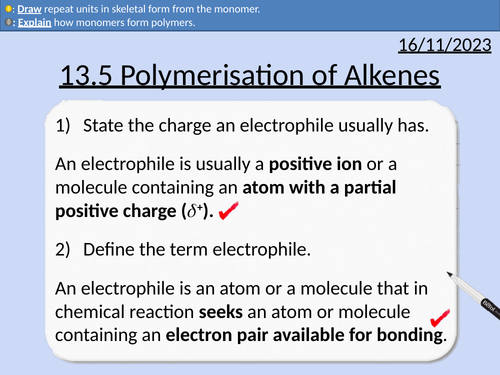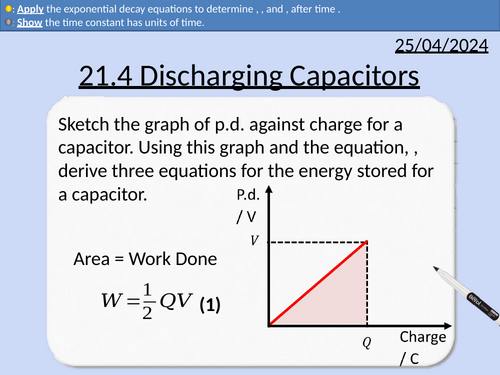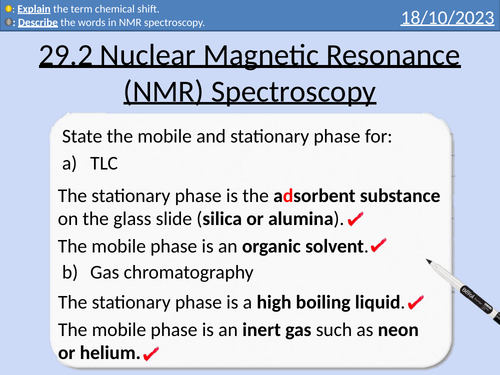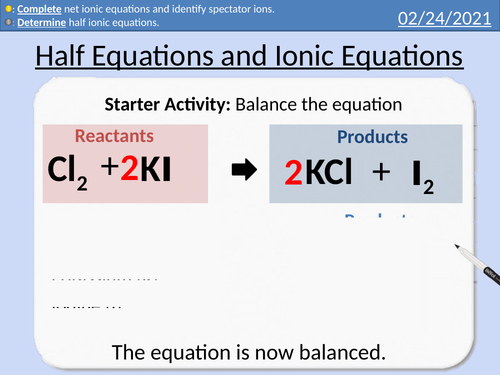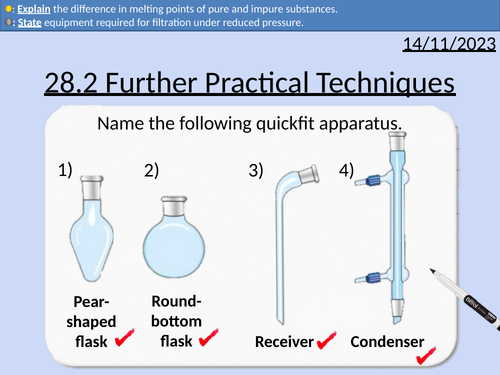548Uploads
208k+Views
81k+Downloads
All resources

GCSE Physics: Acceleration
This presentation covers OCR Gateway Physics 9-1 P1.2.3.
Content covered:
Definition for acceleration
Worked solutions
Students problems with answers
Exam style question with mark scheme

GCSE Chemistry: Redox Reactions
This PowerPoint presentation with worked examples and student questions covers:
• Oxidation and reduction reactions for oxygen
• Identification of oxidation and reduction agents
• Oxidation and reduction reactions for electrons
• Half equations to determine oxidation and reduction

A level Chemistry: Condensation Polymers
OCR A level Chemistry: 27.3 Condensation Polymers
This PowerPoint is a whole lesson included with student activities, animated answers, homework questions with answers provided.
This lesson covers:
Recap of addition polymerisation
Identifying monomers and repeat units from condensation polymers
Polyesters and ester links
Polyamides and amide links
Polyesters and polyamides formed from one monomer
Polyesters and polyamide formed from two monomers
Alkali hydrolysis of polyamides and polyesters
Acid hydrolysis of polyamides and polyesters

OCR A Level Physics: Simple Harmonic Motion and Oscillations
OCR A Level Physics: Simple Harmonic Motion and Oscillations presentation, homework and answers.

GCSE Chemistry: The Structure of Metals
This PowerPoint presentation with worked examples and student questions covers:
• State a use for metals
• Describe the structure of metals
• Why metals make good electrical conductors.
• Metals on the periodic table
Bundle

OCR AS Chemistry: Module 4 Organic Chemistry
This bundle includes all PowerPoint lessons for Module 4 Organic Chemistry.
All PowerPoints are whole lessons included with student activities, animated answers, homework questions with answers provided.
Basic concepts of organic chemistry
Organic Chemistry
Nomenclature of organic compounds
Representing the formulae of organic compounds
Isomerism
Introduction to reaction mechanisms
Alkanes
Properties of the alkanes
Chemical reactions of the alkanes
Alkenes
Properties of the alkenes
Stereoisomerism
Reactions of alkenes
Electrophilic addition in alkenes
Polymerisation in alkenes
Alcohols
Properties of alcohols
Reactions of alcohols
Haloalkanes
The chemistry of haloalkanes
Organohalogen compounds in the environment
Organic Synthesis
Practical techniques in organic chemistry
Synthetic routes
Spectroscopy
Mass spectrometry
Infrared spectroscopy

OCR A level Physics: Capacitors in Circuits
OCR A level Physics: 21.2 Capacitors in Circuits
Module 6 Particles and Medical Physics
This PowerPoint is a whole lesson included with student activities, animated answers, homework questions with answers provided.
This lesson covers:
Uses of capacitors in circuits.
Rules for capacitors in parallel (potential difference, charge, and capacitance).
Rules for capacitors in series (potential difference, charge, and capacitance).
Applying the rules in series and parallel.
Creating a circuit to calculate the charge stored on the capacitor.

GCSE Chemistry: Addition Polymers
This PowerPoint presentation with worked examples and student questions covers:
Prefixes mono- and poly-
Alkanes and alkenes functional groups
Saturated and unsaturated carbon bonds
Addition polymerisation reactions
Conditions needed for polymerisation reactions
How monomers form polymers
Repeat units and monomers

OCR Physics P2 Forces Revision
This revision PowerPoint should take approximately 5 hours of class time to complete.
This PowerPoint covers GCSE OCR Physics Gateway 9-1. Triple and combined (Higher and Foundation) is covered in this material.
** P2.1 Motion:**
Distance, time and speed
Vectors and Scalars
Acceleration
Distance-time graphs
Velocity-time graphs
Kinetic Energy
** P2.2 Newton’s Laws:**
Forces and Interactions
Free Body Diagrams
Newton’s First Law
Newton’s Second Law
Everyday Forces
Momentum
Work Done and Power
P2.3 Forces in Action:
Stretching springs
Stretching materials and storing energy
Gravitational Fields and Potential Energy
Turning Forces
Simple Machines
Hydraulics

OCR AS Chemistry: Electrophilic Addition in Alkenes
OCR AS Chemistry: 13.4 Electrophilic Addition in Alkenes
This PowerPoint is a whole lessons included with student activities, animated answers, homework questions with answers provided.
This lesson covers:
Electrophile molecules
Electronegativity
Reaction mechanisms for addition reaction of alkenes and hydrogen halides
Carbocations and stability
Markownikoff’s Rule

OCR AS Chemistry: Synthetic Routes
OCR AS Chemistry: 16.2 Synthetic Routes
This PowerPoint is a whole lessons included with student activities, animated answers, homework questions with answers provided.
This lesson covers:
Functional Groups - Alkane, Alkene, Haloalkane, Alcohols, Carboxylic Acid, Ketone, Aldehyde, Ester, Amine, Nitrile.
One-step synthetic routes with reagents and conditions
Two-step synthetic routes with reagents and conditions

GCSE Physics: Radiation and the body
This presentation covers OCR Gateway Physics 9-1 P6.2.1 Radiation and the body
This PowerPoint is a whole lessons included with student activities and animated answers.
Background radiation definition
Sources of background radiation
Contamination and irradiation
Medical examples of irradiation - X-rays, sterilisation, gamma knife
Medical examples of contamination - Tracers
Half-life and penetration power for radioactive tracers.

OCR AS Chemistry: 17.1 Mass Spectrometry
OCR AS Chemistry: 17.1 Mass Spectrometry
This PowerPoint is a whole lessons included with student activities, animated answers, homework questions with answers provided.
This lesson covers:
Molecular ions M+
M + 1 peak
Fragment ions
Identifying molecules from a mass spectrum

OCR AS Chemistry: Polymerisation of Alkenes
OCR AS Chemistry: 13.5 Polymerisation of Alkenes
This PowerPoint is a whole lessons included with student activities, animated answers, homework questions with answers provided.
This lesson covers:
Monomers and repeat units
Addition Polymerisation for:
Polyethene
Polypropene
Polylactate
Polystyrene
Polyvinyl Chloride (PVC)
Environmental Concerns from polymers including:
Combustion of polymers
recycling PVC
biogradeable bioplastics
photodegradable polymers
feedstock recycling

OCR A level Physics: Discharging Capacitors
OCR A level Physics: 21.4 Discharging Capacitors
Module 6 Particles and Medical Physics
This PowerPoint is a whole lesson included with student activities, animated answers, homework questions with answers provided.
This lesson covers:
Exponential increase and exponential decay
Explaining how capacitors discharge through a resistor in parallel
Definition of time constant for a capacitor
Showing that time constant has units of seconds
Iterative method for finding how capacitors discharge
Using exponentials and logs.
Solving a differential equation (needed for A-level Maths).

GCSE Physics: Series and Parallel Circuits
This presentation covers OCR Gateway Physics 9-1 P3.2.2 Series and Parallel Circuits
Rule for current in series and parallel circuits
Rule for potential difference in series and parallel circuits.
Working scientifically
Student activities with worked solutions
Exam questions with worked solutions

A level Chemistry: Nuclear Magnetic Resonance (NMR) Spectroscopy
OCR A level Chemistry: 29.2 Nuclear Magnetic Resonance (NMR) Spectroscopy
This PowerPoint is a whole lesson included with student activities, animated answers, homework questions with answers provided.
This lesson covers:
Nuclear Spin
Resonance
Tetramethylsilane (TMS)
Chemical Shift ẟ

GCSE Chemistry: Half Equations and Ionic Equations
This PowerPoint presentation with worked examples and student questions covers:
• Precipitation in chemical reactions
• Definition of ions
• Ionic Half equations
• Dot and cross diagrams for electron structure
• Introduction to full ionic equations and net ionic equations
Bundle

OCR A level Chemistry: Amines, Amino Acids, and Polymers
OCR A level Chemistry: Aromatic Compounds is apart of the Module 6: Organic Chemistry and Analysis.
All presentations come with worked examples, solutions and homeworks.
27.1 Amines
27.2 Amino acids, Amides and Chirality
27.3 Condensation Polymers
Aliphatic and aromatic hydrocarbons
Amines being derived from ammonia (NH3)
Classifying amines as primary, secondary, and tertiary
Naming amines
Naming ammonium salts
Amines neutralisation reactions with acids
Preparation of aliphatic amines
Preparation of aromatic amines
Locants: alpha, beta, and gamma
Functional groups of amino acids
General formula for amino acids
Reactions of amino acids (alkali and acid)
Esterification of amino acids
Amide functional groups
Naming amide molecules
Drawing optical isomers
Explanation of superimposable and non-superimposable images
Identifying chiral centers
Recap of addition polymerisation
Identifying monomers and repeat units from condensation polymers
Polyesters and ester links
Polyamides and amide links
Polyesters and polyamides formed from one monomer
Polyesters and polyamide formed from two monomers
Alkali hydrolysis of polyamides and polyesters
Acid hydrolysis of polyamides and polyesters

A level Chemistry: Further Practical Techniques
OCR A level Chemistry: 28.2 Further Practical Techniques
This PowerPoint is a whole lesson included with student activities, animated answers, homework questions with answers provided.
This lesson covers:
Filtration under reduced pressure
Purification through Recrystallisation
Preparation of Melting Point Sample
Melting point determination with an electric heater
Melting point determination with a Thiele tube


